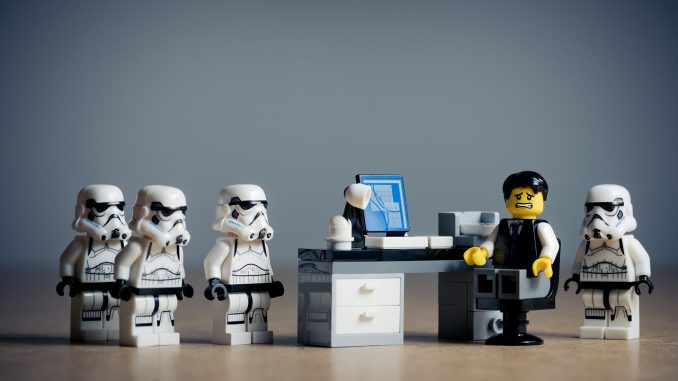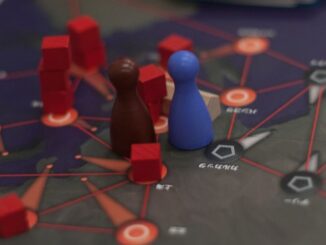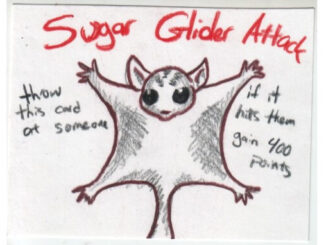
“Good morning, everyone, and welcome to the first day of the crisis response wargame! Please note that the crisis actually started three days ago. Half of your computers are down, a third of your employees are sick, the bathroom pipes burst last night, and you’re fresh out of coffee filters. Be ready to present your opening moves in 20 minutes. Time starts now.”
The stress is palpable and dialed to 11. Tempers flare, emotions boil, and sweat-soaked game pieces fly as teams scramble from one crisis inject to another. The word “fun” likely doesn’t come to mind, but harnessing stress in training and education wargames transports players to a new world where emotions, thrill, and learning are real, and the risk illusory. Overcoming obstacles in high-stress training and educational wargames bolsters player confidence, strengthens interpersonal trust, and fosters team cohesion.
With inspiration from John Curry, Jim Dunnigan, Peter Perla, and Phil Sabin, I define wargaming as a synthetic decision making test under conditions of uncertainty against thinking opponents, which generates insights but not proven outcomes, engages multiple learning types, and builds team cohesion in a risk-free environment.[1] With one caveat. Most wargame literature highlights competition between thinking opponents, or human teams. I’ll step slightly out of bounds in suggesting that game controllers and adjudicators can proxy as non-thinking opponents such as pandemics, storms, power outages, accidents, earthquakes, zombie apocalypses, or other similar scenarios where human players must respond to uncontrollable and varyingly predictable events. Training and education wargame methods further overlap with analytic wargames; however, training and education wargaming focuses on active learning and skill reinforcement, while analytic wargaming focuses on hypothesis and decision generation for a given problem. Even so, harnessing stress applies to both approaches. I’m also enlarging the discourse to include not just tabletop, seminar, and matrix wargames that are largely rules and narrative-driven, but also live training exercises that translate piece movement into players actually practicing their skillsets.

How does stress reinforce wargame learning outcomes? In my own research I draw on Johan Huizinga’s magic circle, Peter Perla’s synthetic experience, and Roger Caillois’ liminality; or, that games are ritual spaces inside which all actions and consequences are real to the players.[2] Everything the players experience–their anger and failures, their frustrations and “ah ha!” moments, their elation and successes–imprints on their minds as if the experience happened in real life, yet in a risk-free environment. Put differently, how many Ludogogy readers can’t remember what they ate for breakfast yesterday but easily recall well-played games from decades past in stark clarity? Liminality also reinforces teamwork, as achieving goals under duress forges immense rapport between players. In particular, changes across the following four points effectively invoke stress that jumpstart liminality:
- Dispossession. Adjusting available resources for completing objective(s).
- Temporal. Adjusting available time to complete objective(s).
- Spatial. Adjusting available space.
- Sensory. Stimulating player senses.
From these four points, creative designers, controllers, and referees can generate a wide variety of useful, relevant, and occasionally devious stress-inducing methods. The key is to review and ensure that chosen stress injects positively contribute to the wargame’s overall learning objective(s). Also, tailor methods to match the trainees: first responders will expect a blend of physical and mental challenges, while a trade negotiator is likely to expect an almost entirely mental experience. Although not all-inclusive, I’ve used–and lived through–the ten below methods with great success across almost three decades of wargaming. All of these methods also tap one or more of the above points:
Barriers. Creating physical or communicative distances between teams. If space permits, place teams in different rooms or buildings and restrict their travel. If space is at a premium, restrict how teams communicate–perhaps one team has cell phones while another is limited to paper notes. You’ll be surprised by player creativity: a colleague once applied the phone/paper communication method, and the paper-limited team won the exercise.
Blackout. Dramatically reduce player access to critical resources. In board, seminar, or matrix wargames this might mean removing game pieces representing player capabilities or covering computer screens and locking doors during a hands-on training exercise. The immediate shock is immense. Put differently, imagine relearning to navigate without a Google Map. Again, stress foster enlightenment. What starts as a flurry or panic (usually) shifts to creative information workarounds.
Day -/+. Decreasing or increasing time available to players. Decreasing time appears the most stressful at face value, especially when paired with an audible or visual countdown. However, increasing time is also useful when paired with a suitably enlarged problem. For example, in the 1980s a team of senior officers opened a wargame expecting to practice a strategic-level problem with divisions, air wings, and carrier groups already in theater. Much to their surprise (and some dismay), the actual problem had planned forces still great distances from the theater, and the officers were tasked to figure out how to move them. Yes, their time available was extended, but now logistics details such as road widths, railroad gauges, and runway lengths mattered far more than initially expected.[3]
Decimation. The actual definition means to kill one of every ten people in a group as a form of punishment. But I’ll apply the vernacular version and characterize this as removing a percentage of the player’s human capital, either in raw numbers or selective positions (such as temporarily removing the commander or CEO for having eaten a bad batch of shrimp). Although injects can be random–particularly at STARTEX, or “start of exercise”–the decimation technique ideally ebbs and flows naturally based on player actions and their consequences.
Environment. Make the gaming space slightly uncomfortable. Dim the lights and make the room just a few degrees warmer or colder. Play sound effects or music with varying tempos. Restricting player senses while simultaneously enhancing others invokes shifts a simple room into unworldly realms. One note of caution, though. In my experience, increasing lighting breaks the magic circle and is usually a visual cue for ENDEX, or “end of exercise.”
Fatigue. Your people will hate you for this, but fatigue works. Start, end, or extend the wargame before, after, or beyond normal hours. The game space grows increasingly surreal to players, while creeping fatigue both challenges thinking and increases liminal receptivity.

Green Army Soldiers. In homage to the toys I spent many youthful days placing, marching, and occasionally melting, in this method referees ensure that the game space includes visual and tactile triggers. For a military wargame, I might tastefully place swatches of camouflage netting and spare maps in the room. For a business wargame, arranged notepads and newspapers. And regardless of setting, players find dice and cards almost irresistible to touch, and the act of handling dice and cards open players to liminality.[4] Like an elaborate or sparsely-furnished stage play, even small details transport player’s minds across the magic circle.
(Not) Just-in-Time. A nuance from point-of-failure below, this is a challenge outside of the team’s immediate control, such as a vendor sold out of critical supply stocks or an extended major airport hub closure. This method is particularly useful for creative generation of workarounds, substitutions, and alternate course of action development.
Point-of-Failure. In contrast to (not) just-in-time, this represents a significant challenge within the organization. Think having the only employee who knows the finance database’s password hospitalized, or the same database corrupted and without software backups. In my experience, this method results in the most spectacular flameouts matched with equally sobering and actionable post-wargame lessons learned.
Pre-Mortem. Turning the stress on its head! Allow teams to plan their strategies in bucolic bliss, then immediately before the opening moves, inform the teams their strategies failed and ask them to draft a list of reasons why. This method’s stress come from sudden surprise and sowing of doubt but generates great discussion. Sometimes the teams stick to their plan–and emerge victorious.

High-stress wargames, however, require expertise, proper skill level alignment, and emotional decompression. First, high stress wargaming demands highly experienced adjudicators. This octane of wargaming is equally stressful for those running it, as adjudicators must also think on their feet and make realistic calls under conditions of fatigue, poor lighting, and bad coffee (actually, there’s no excuse for bad coffee). Second, using the “crawl-walk-run” learning methodology, high-stress wargaming for training and education is more effective for reinforcing experienced personnel (walkers and runners). However, you can mitigate inexperience by pairing crawlers with experienced trainees. Finally, failure in high-stress wargames can result in players carrying blame outside of the game space that affects real-world perceptions. The post-wargame debriefing is where you nip the blame pathology in the bud. In addition to capturing best practices, lessons learned, and new ideas, the debrief is when players individually discuss their actions, make amends, and focus on praise. Take your learning and new confidence with you but leave negative emotions behind in the circle.
Although I’ve focus on training and education wargames, as a takeaway I offer that stress reinforces learning and teamwork in any game genre, even for pure entertainment. Well-applied stress creates powerful organization knowledge laboratories and immense rapport amongst friends around the gaming table. The next time you build an employee training event or game convention dungeon crawl, give the players a memorable experience–harness stress and conjure an unforgettable magic circle.
References and further reading
[1]Fielder, James. (2020). “Reflections on Teaching Wargame Design.” War on the Rocks. https://warontherocks.com/2020/01/reflections-on-teaching-wargame-design/ (accessed October 26, 2020).
[2]Huizinga, Johan. (2014). Homo Ludens: A Study of the Play Element in Culture. Mansfield Center: Martino Publishing; Curry, John (ed.). (2011). Peter Perla’s The Art of Wargaming: A Guide for Professionals and Hobbyists. Lulu.com; Sabin, Philip. (2014). Simulating War: Studying Conflict through Simulation Games. New York: Bloomsbury Academic; Caillois, Roger. (2001). Man, Play and Games. Champaign: The University of Illinois Press.
[3]Allen, Thomas B. (1989). War Games: The Secret World of the Creators, Players, and Policy Makers Rehearsing World War III Today. New York: Berkley Books.
[4] Sabin, Philip. (2014). Simulating War: Studying Conflict through Simulation Games. New York: Bloomsbury Academic.
- Start on Day 3: Liminality in High-Stress Wargames - 5th November 2020





Be the first to comment